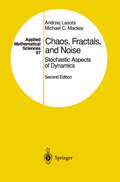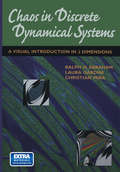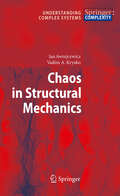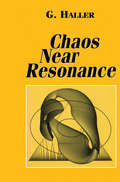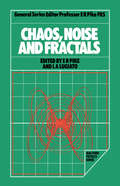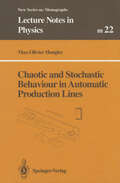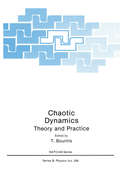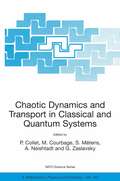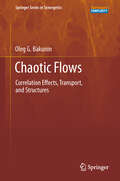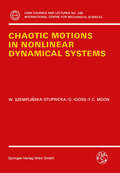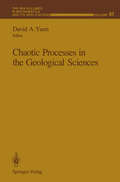- Table View
- List View
Chaos, Fractals, and Dynamics
by P. FischerThis book contains eighteen papers, all more-or-less linked to the theory of dynamical systems together with related studies of chaos and fractals. It shows many fractal configurations that were generated by computer calculations of underlying two-dimensional maps.
Chaos, Fractals, and Noise: Stochastic Aspects of Dynamics (Applied Mathematical Sciences #97)
by Andrzej Lasota Michael C. MackeyThe first edition of this book was originally published in 1985 under the ti tle "Probabilistic Properties of Deterministic Systems. " In the intervening years, interest in so-called "chaotic" systems has continued unabated but with a more thoughtful and sober eye toward applications, as befits a ma turing field. This interest in the serious usage of the concepts and techniques of nonlinear dynamics by applied scientists has probably been spurred more by the availability of inexpensive computers than by any other factor. Thus, computer experiments have been prominent, suggesting the wealth of phe nomena that may be resident in nonlinear systems. In particular, they allow one to observe the interdependence between the deterministic and probabilistic properties of these systems such as the existence of invariant measures and densities, statistical stability and periodicity, the influence of stochastic perturbations, the formation of attractors, and many others. The aim of the book, and especially of this second edition, is to present recent theoretical methods which allow one to study these effects. We have taken the opportunity in this second edition to not only correct the errors of the first edition, but also to add substantially new material in five sections and a new chapter.
Chaos in Astronomy: Conference 2007 (Astrophysics and Space Science Proceedings)
by G. Contopoulos P. A. PatsisChaos in Classical and Quantum Mechanics (Interdisciplinary Applied Mathematics #1)
by Martin C. GutzwillerDescribes the chaos apparent in simple mechanical systems with the goal of elucidating the connections between classical and quantum mechanics. It develops the relevant ideas of the last two decades via geometric intuition rather than algebraic manipulation. The historical and cultural background against which these scientific developments have occurred is depicted, and realistic examples are discussed in detail. This book enables entry-level graduate students to tackle fresh problems in this rich field.
Chaos in Discrete Dynamical Systems: A Visual Introduction in 2 Dimensions
by Ralph Abraham Laura Gardini Christian MiraThe materials in the book and on the accompanying disc are not solely developed with only the researcher and professional in mind, but also with consideration for the student: most of this material has been class-tested by the authors. The book is packed with some 100 computer graphics to illustrate the material, and the CD-ROM contains full-colour animations tied directly to the subject matter of the book itself. The cross-platform CD also contains the program ENDO, which enables users to create their own 2-D imagery with X-Windows. Maple scripts are provided to allow readers to work directly with the code from which the graphics in the book were taken.
Chaos in Hydrology: Bridging Determinism and Stochasticity
by Bellie SivakumarThis authoritative book presents a comprehensive account of the essential roles of nonlinear dynamic and chaos theories in understanding, modeling, and forecasting hydrologic systems. This is done through a systematic presentation of: (1) information on the salient characteristics of hydrologic systems and on the existing theories for their modeling; (2) the fundamentals of nonlinear dynamic and chaos theories, methods for chaos identification and prediction, and associated issues; (3) a review of the applications of chaos theory in hydrology; and (4) the scope and potential directions for the future.This book bridges the divide between the deterministic and the stochastic schools in hydrology, and is well suited as a textbook for hydrology courses.
Chaos in Structural Mechanics (Understanding Complex Systems)
by Jan Awrejcewicz Vadim Anatolevich Krys'koChaos Near Resonance (Applied Mathematical Sciences #138)
by G. HallerA unified treatment of resonant problems with special emphasis on the recently discovered phenomenon of homoclinic jumping. After a survey of the necessary background, the book develops a general finite dimensional theory of homoclinic jumping, illustrating it with examples. The main mechanism of chaos near resonances is discussed in both the dissipative and the Hamiltonian context, incorporating previously unpublished new results on universal homoclinic bifurcations near resonances, as well as on multi-pulse Silnikov manifolds. The results are applied to a variety of different problems, which include applications from beam oscillations, surface wave dynamics, nonlinear optics, atmospheric science and fluid mechanics.
Chaos, Noise and Fractals
by E R Pike; L A LugiatoThe study of nonlinear dynamical systems has been gathering momentum since the late 1950s. It now constitutes one of the major research areas of modern theoretical physics. The twin themes of fractals and chaos, which are linked by attracting sets in chaotic systems that are fractal in structure, are currently generating a great deal of excitement. The degree of structure robustness in the presence of stochastic and quantum noise is thus a topic of interest. Chaos, Noise and Fractals discusses the role of fractals in quantum mechanics, the influence of phase noise in chaos and driven optical systems, and the arithmetic of chaos. The book represents a balanced overview of the field and is a worthy addition to the reading lists of researchers and students interested in any of the varied, and sometimes bizarre, aspects of this intriguing subject.
Chaos, Noise and Fractals
by E. Roy Pike L. A. LugiatoThe study of nonlinear dynamical systems has been gathering momentum since the late 1950s. It now constitutes one of the major research areas of modern theoretical physics. The twin themes of fractals and chaos, which are linked by attracting sets in chaotic systems that are fractal in structure, are currently generating a great deal of excitement. The degree of structure robustness in the presence of stochastic and quantum noise is thus a topic of interest. Chaos, Noise and Fractals discusses the role of fractals in quantum mechanics, the influence of phase noise in chaos and driven optical systems, and the arithmetic of chaos. The book represents a balanced overview of the field and is a worthy addition to the reading lists of researchers and students interested in any of the varied, and sometimes bizarre, aspects of this intriguing subject.
Chaos, Order, and Patterns (Nato Science Series B: #280)
by Roberto Artuso Predrag Cvitanovic Giulio CasatiProceedings of a NATO ASI held in Lake Como, Italy, June 25--July 6, 1990
Chaos: A Statistical Perspective (Springer Series in Statistics)
by Kung-Sik Chan Howell TongThis book discusses dynamical systems that are typically driven by stochastic dynamic noise. It is written by two statisticians essentially for the statistically inclined readers. It covers many of the contributions made by the statisticians in the past twenty years or so towards our understanding of estimation, the Lyapunov-like index, the nonparametric regression, and many others, many of which are motivated by their dynamical system counterparts but have now acquired a distinct statistical flavor.
Chaos, Synchronization and Structures in Dynamics of Systems with Cylindrical Phase Space (Understanding Complex Systems)
by Nikolai Verichev Stanislav Verichev Vladimir ErofeevThis book develops analytical methods for studying the dynamical chaos, synchronization, and dynamics of structures in various models of coupled rotators. Rotators and their systems are defined in a cylindrical phase space, and, unlike oscillators, which are defined in Rn, they have a wider “range” of motion: There are vibrational and rotational types for cyclic variables, as well as their combinations (rotational-vibrational) if the number of cyclic variables is more than one. The specificity of rotator phase space poses serious challenges in terms of selecting methods for studying the dynamics of related systems. The book chiefly focuses on developing a modified form of the method of averaging, which can be used to study the dynamics of rotators. In general, the book uses the “language” of the qualitative theory of differential equations, point mappings, and the theory of bifurcations, which helps authors to obtain new results on dynamical chaos in systems with few degrees of freedom. In addition, a special section is devoted to the study and classification of dynamic structures that can occur in systems with a large number of interconnected objects, i.e. in lattices of rotators and/or oscillators. Given its scope and format, the book can be used both in lectures and courses on nonlinear dynamics, and in specialized courses on the development and operation of relevant systems that can be represented by a large number of various practical systems: interconnected grids of various mechanical systems, various types of networks including not only mechanical but also biological systems, etc.
Chaos, Turbulenzen und kosmische Selbstorganisationsprozesse
by Ulrich Von KusserowDieses Buch bietet eine anschauliche und reich bebilderte Übersicht zur Vielfalt kosmischer Turbulenz- und Selbstorganisationsszenarien und ermöglicht umfassende Einblicke in die dabei in ganz unterschiedlichen Zusammenhängen ablaufenden Vorgänge und zugrundeliegenden theoretischen Konzepte. Es richtet sich an fachwissenschaftlich interessierte Laien, Studenten und Wissenschaftler, die einen Einstieg in diese Themenbereiche suchen. Der Autor zeigt auf, nach welchen Gesetzen Selbstorganisationsprozesse überall im Kosmos insbesondere auch die Entstehung der Galaxien, Sterne und Planeten sowie die Entwicklung des Lebens auf dem Planeten Erde möglich gemacht haben. In ansprechender Weise schlägt er einen weiten Bogen über eine Vielzahl chaotischer Vorgänge und Turbulenzen, geordneter Strukturbildungs- und Entwicklungsprozesse in der Natur, die uns Menschen aus dem Alltagsleben teilweise sehr wohl bekannt sind. Die näheren Erläuterungen mathematisch-physikalischer Modellierungsansätze und wissenschaftlicher Forschungsmethoden ermöglichen dem Leser ein wesentlich grundlegenderes Verständnis der dabei Einfluss nehmenden physikalischen, chemischen und biologischen Prozesse.
Chaos und Systeme: Eine Einführung in Theorie und Simulation dynamischer Systeme
by Morton John CantyDieses Buch ist eine besonders geeignete Einführung zum Thema Chaos und Simulation dynamischer Systeme für Studenten der Ingenieur- und der Naturwissenschaften. Die Untersuchung von einfachen Modellen aus der Populationsdynamik dient als Vehikel, einen schnellen und zielgerichteten Einstieg zu erzielen. Das nötige mathematische und simulationstechnische Werkzeug wird nach Bedarf eingeführt und gut verständlich erklärt. Unterstützt wird die Darstellung durch Programme auf beiliegender Diskette, die die Zusammenhänge verdeutlichen und zum Experimentieren anregen.
Chaotic and Fractal Dynamics: Introduction for Applied Scientists and Engineers
by Francis C. MoonA revision of a professional text on the phenomena of chaotic vibrations in fluids and solids. Major changes reflect the latest developments in this fast-moving topic, the introduction of problems to every chapter, additional mathematics and applications, more coverage of fractals, numerous computer and physical experiments. Contains eight pages of 4-color pictures.
Chaotic and Stochastic Behaviour in Automatic Production Lines (Lecture Notes in Physics Monographs #22)
by Max-Olivier HonglerInspired by the general configuration characteristics of automatic production lines, the author discusses the modelisation of important sectors of a factory. Typical topics such as parts feeders, part orienting devices, insertion mechanisms and buffered flows are analysed using random evolution models and non-linear dynamical systems theory.
Chaotic Dynamics: Theory and Practice (Nato Science Series B: #298)
by T. BountisMany conferences, meetings, workshops, summer schools and symposia on nonlinear dynamical systems are being organized these days, dealing with a great variety of topics and themes -classical and quantum, theoretical and experimental. Some focus on integrability, or discuss the mathematical foundations of chaos. Others explore the beauty of fractals, or examine endless possibilities of applications to problems of physics, chemistry, biology and other sciences. A new scientific discipline has thus emerged, with its own distinct philosophical viewpoint and an impressive arsenal of new methods and techniques, which may be called Chaotic Dynamics. Perhaps its most outstanding achievement so far has been to shed new light on many long standing issues involving complicated, irregular or "chaotic" nonlinear phenomena. The concepts of randomness, complexity and unpredictability have been critically re-examined and the fundamental importance of scaling, self-similarity and sensitive dependence on parameters and initial conditions has been firmly established. In this NATO ASI, held at the seaside Greek city of Patras, between July 11- 20, 1991, a serious effort was made to bring together scientists representing many of the different aspects of Chaotic Dynamics. Our main aim was to review recent advances, evaluate the current state of the art and identify some of the more promising directions for research in Chaotic Dynamics.
Chaotic Dynamics and Transport in Classical and Quantum Systems: Proceedings of the NATO Advanced Study Institute on International Summer School on Chaotic Dynamics and Transport in Classical and Quantum Systems, Cargèse, Corsica, 18 - 30 August 2003. (NATO Science Series II: Mathematics, Physics and Chemistry #182)
by M. Courbage S. Métens A. Neishtadt G. Zaslavsky Pierre ColletFrom the 18th to the 30th August 2003 , a NATO Advanced Study Institute (ASI) was held in Cargèse, Corsica, France. Cargèse is a nice small village situated by the mediterranean sea and the Institut d'Etudes Scientifiques de Cargese provides ? a traditional place to organize Theoretical Physics Summer Schools and Workshops * in a closed and well equiped place. The ASI was an International Summer School on "Chaotic Dynamics and Transport in Classical and Quantum Systems". The main goal of the school was to develop the mutual interaction between Physics and Mathematics concerning statistical properties of classical and quantum dynamical systems. Various experimental and numerical observations have shown new phenomena of chaotic and anomalous transport, fractal structures, chaos in physics accelerators and in cooled atoms inside atom-optics billiards, space-time chaos, fluctuations far from equilibrium, quantum decoherence etc. New theoretical methods have been developed in order to modelize and to understand these phenomena (volume preserving and ergodic dynamical systems, non-equilibrium statistical dynamics, fractional kinetics, coupled maps, space-time entropy, quantum dissipative processes etc). The school gathered a team of specialists from several horizons lecturing and discussing on the achievements, perspectives and open problems (both fundamental and applied).
Chaotic Flows: Correlation Effects, Transport, and Structures (Springer Series in Synergetics #10)
by Oleg G. BakuninThe book introduces readers to and summarizes the current ideas and theories about the basic mechanisms for transport in chaotic flows. Typically no single paradigmatic approach exists as this topic is relevant for fields as diverse as plasma physics, geophysical flows and various branches of engineering. Accordingly, the dispersion of matter in chaotic or turbulent flows is analyzed from different perspectives. Partly based on lecture courses given by the author, this book addresses both graduate students and researchers in search of a high-level but approachable and broad introduction to the topic.
Chaotic, Fractional, and Complex Dynamics: New Insights and Perspectives (Understanding Complex Systems)
by Mark Edelman Elbert E. Macau Miguel A. SanjuanThe book presents nonlinear, chaotic and fractional dynamics, complex systems and networks, together with cutting-edge research on related topics.The fifteen chapters – written by leading scientists working in the areas of nonlinear, chaotic, and fractional dynamics, as well as complex systems and networks – offer an extensive overview of cutting-edge research on a range of topics, including fundamental and applied research. These include but are not limited to, aspects of synchronization in complex dynamical systems, universality features in systems with specific fractional dynamics, and chaotic scattering.As such, the book provides an excellent and timely snapshot of the current state of research, blending the insights and experiences of many prominent researchers.
Chaotic Motions in Nonlinear Dynamical Systems (CISM International Centre for Mechanical Sciences #298)
by Wanda Szemplinska-Stupnicka Gerard Iooss Francis C. MoonDiscoveries of chaotic, unpredictable behaviour in physical deterministic systems has brought about new analytic and experimental techniques in dynamics. The modern study of the new phenomena requires the analyst to become familiar with experiments (at least with numerical ones), since chaotic solutions cannot be written down, and it requires the experimenter to master the new concepts of the theory of nonlinear dynamical systems. This book is unique in that it presents both viewpoints: the viewpoint of the analyst and of the experimenter. In the first part F. Moon outlines the new experimental techniques which have emerged from the study of chaotic vibrations. These include Poincaré sections, fractial dimensions and Lapunov exponents. In the text by W. Szemplinska-Stupnicka the relation between the new chaotic phenomena and classical perturbation techniques is explored for the first time. In the third part G. Iooss presents methods of analysis for the calculations of bifurcations in nonlinear systems based on modern geometric mathematical concepts.
Chaotic Processes in the Geological Sciences (The IMA Volumes in Mathematics and its Applications #41)
This IMA Volume in Mathematics and its Applications CHAOTIC PROCESSES IN THE GEOLOGICAL SCIENCES is based on the proceedings of a workshop which was an integral part of the 1989- 90 IMA program on "Dynamical Systems and their Applications". The workshop was intended to be an arena for scientific exchanges between earth scientists and mathematical researchers, especially with experts in dynamical systems. We thank Shui-Nee Chow, Martin Golubitsky, Richard McGehee, George R. Sell and David Yuen for organizing the meeting. We especially thank David Yuen for editing the proceedings. We also take this opportunity to thank those agencies whose financial support made the workshop possible: the Army Research Office, the Minnesota Supercomputer Institute, the National Science Foundation, and the Office of Naval Research. A vner Friedman Willard Miller, Jr. PREFACE The problems in geological sciences have many nonlinearities from the nature of the complicated physical laws which give rise to strongly chaotic behavior. Foremost and most visible are earthquakes and volcanic eruptions, more subtle are the time dependent variations of the Earth's magnetic fields and motions of the surface plates.
The Chaotic Solar Cycle (Atmosphere, Earth, Ocean & Space)
by Arnold HanslmeierThis book offers an overview of solar physics with a focus on solar activity, particularly the activity cycle. It is known that solar activity varies periodically, but there are also phases of intermittency, such as the Maunder minimum, during which solar activity is very low or high over several decades. The book provides a brief introduction to chaos theory and investigates solar activity in terms of its chaotic behavior. It also discusses how intermittent phases of solar activity have affected and can affect Earth’s climate and long-term space weather, and reviews the underlying theories relating to the solar dynamo mechanism. Furthermore, each chapter includes references to scientific literature (review articles and papers) so that readers can delve deeper into the subjects covered. This richly illustrated book will appeal to a wide readership, and is also useful as a textbook for courses in solar physics and astrophysics.
Chaotic Transport in Dynamical Systems (Interdisciplinary Applied Mathematics #2)
by Stephen WigginsProvides a new and more realistic framework for describing the dynamics of non-linear systems. A number of issues arising in applied dynamical systems from the viewpoint of problems of phase space transport are raised in this monograph. Illustrating phase space transport problems arising in a variety of applications that can be modeled as time-periodic perturbations of planar Hamiltonian systems, the book begins with the study of transport in the associated two-dimensional Poincaré Map. This serves as a starting point for the further motivation of the transport issues through the development of ideas in a non-perturbative framework with generalizations to higher dimensions as well as more general time dependence. A timely and important contribution to those concerned with the applications of mathematics.

